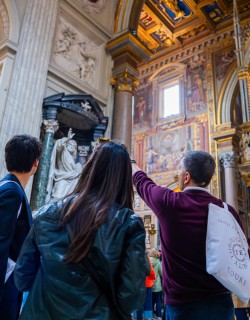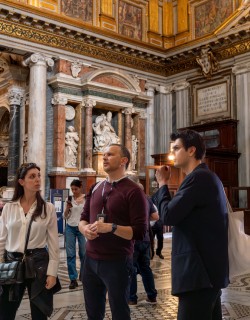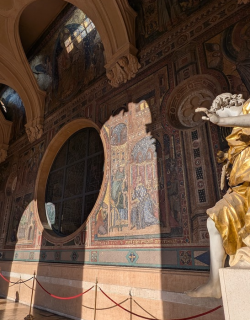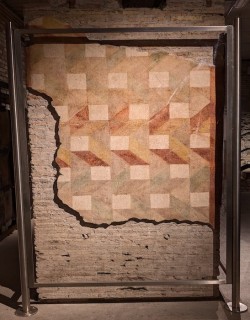Mealtimes have always been an important part of Italian life. There’s still a lunchtime rush hour in Rome today, as workers travel home for lunch, while sampling the local cuisine in a trattoria or on an Rome food tour is a highlight of any Roman holiday.
But what about the ancient Romans? Many people today imagine the Romans reclining on sumptuous couches, gorging on dormice and then rushing off to the vomitorium to be copiously sick, before returning to enjoy the rest of the meal. Our fantasy image of ancient Rome is one of total excess, with hedonistic emperors and decadent banquets, but unfortunately it’s not entirely true. While there may have been a bit of vomiting and dormouse consumption, that wasn’t exactly an average meal for an ordinary Roman.
Thanks to a variety of sources - archaeological remains, art, and even ancient cookbooks - we have a pretty good idea of what a Roman banquet would have looked like. The Romans copied the Greek model of lying down on beds, which were placed in a U shape in the triclinium (dining room).
In Rome, archaeologists have found many examples of these kinds of dining rooms. One of the most interesting is the Cenatio Jovis, located in the luxurious imperial palace of Domitian on the Palatine Hill. The remains of a marble floor have been found here, as well as the underground ducts used to heat the room. These findings, along with other aspects of social life in Ancient Rome, are discussed at length by our archaeologist guide on our in-depth Private Tour of the Colosseum and Ancient Rome, a journey through the places and culture of Ancient Rome.
Ordinary meals might have been taken sitting down or even standing up, but for a lengthy banquet, Romans preferred to recline. The arrangement of the beds and the seating plan depended on the guests. The lectus medius (middle couch) was the most desirable, as it allowed easy conversation with the host, who sat to the right, as well as the best view of the garden or courtyard through the window. In Virgil’s Aeneid, Queen Dido sits on the middle couch, between Aeneas and Cupid - further evidence of the middle being a privileged position.
A Roman banquet would begin at around 5pm and include multiple courses. A typical menu might include cheese and salad as a starter, with a lot of meat or fish as the main course. Poultry, deer, rabbit or goat were popular, as were all kinds of fish and seafood. The meal would be accompanied with lots of garum - a very popular fish sauce that Romans liked to put on everything - as well as watered-down wine. Dormice were sometimes eaten, despite a law forbidding their consumption, but only at the most extravagant dinner parties, along with other exotic delicacies like the roast parrot, milk-fed snails and rabbit foetuses. Dessert was usually something simple, such as fruits or nuts with honey.
Despite the excessive quantities of food consumed at certain banquets, the myth of intentional vomiting and frequent trips to the vomitorium is just that - a myth. The truth is arguably more disgusting, as Seneca implies that one of the many unpleasant jobs slaves had to do after a banquet was to “collect the leavings of the drunks”. There’s also no evidence that Romans forced themselves to throw up just so they could eat more, although when you read lists of the dishes they indulged in at the most decadent banquets, it’s hardly surprising they felt queasy.
The vomitorium - supposedly a room where people went to vomit during a meal - appeals to the public imagination, perhaps because it feeds into our fantasy of ancient Rome as a place of excess and hedonism. But unfortunately, the vomitorium as we imagine it didn’t exist. Romans did not interrupt to their meals to rush off to a specially designed room just so they could throw up. In reality, a vomitorium was something completely different - a passage below the seats in an amphitheatre that allowed large crowds to exit rapidly. The word “vomitorium” derives from the Latin verb meaning “to spew forth”, but it referred to the building “spewing” people, rather than people spewing food.
A Roman banquet was designed to impress the guests, so fancy food was not enough. Some kind of entertainment was expected, such as music or poetry. The meal might be accompanied by flautists, acrobats, dancers, or recitals of poetry such as Virgil’s Aeneid. At the most spectacular dinner parties there were even gladiatorial fights or trained lions or leopards to keep the guests entertained as they tucked into their dormice. In the words of Katherine Raff, “the Roman banquet was not merely a meal but rather a calculated spectacle of display that was intended to demonstrate the host's wealth, status, and sophistication to his guests”.
These kinds of lavish banquets were the exception rather than the rule, and you’re unlikely to find anything quite so extravagant in modern day Rome.
~by Alexandra Turney~



